Showdown in Group E! On the 3rd and last matchday of Group E, Costa Rica and Germany met at the Al Bayt Stadium. Costa Rica surprisingly won their last match 1-0 against Japan and thus still had a chance to reach the round of 16.
With only one point, Germany, who were at the bottom of the group going into this one, was under the most pressure – but could still progress through various constellations.
If Spain won against Japan at the same time, a win would have been enough for Germany. If Japan drew, Germany had to win by two goals to advance. Otherwise, in the case of a narrow victory, it depended on the more goals scored between Germany and Japan.
After the final whistle, it was finally sealed that Germany would be eliminated from the group stage of a World Cup for the second time in a row. Costa Rica lost the match, but in the meantime were in second place in the group. They were able to make the most of their few chances, as they did against Japan, and thus shocked Germany.
In this tactical analysis article, we will focus on Germany’s tactics in both offensive and defensive situations. In addition, we will analyse Costa Rica’s switching situations in more detail. But first, we will start the analysis by introducing the two lineups.
Lineups
Luis Fernando Suarez sent his team out on the pitch in a 5-4-1 system. Keylor Navas of Paris Saint Germain played in goal. Keysher Fuller, Oscar Duarte, Kendall Waston, Juan Pablo Vargas and Bryan Oviedo formed the back five in front of him. Costa Rica’s two central midfielders were Celso Borges and Yeltsin Tejeda. Brandon Aguilera and top star Joel Campbell started on the two flanks. The only striker for Costa Rica was Johan Venegas.
Hansi Flick lined up his team in a 4-2-3-1 system. Manuel Neuer played in goal and the backline consisted of David Raum, Antonio Rüdiger, Niklas Süle and Joshua Kimmich, who moved from the centre to the right-back position. The two defensive midfielders were Leon Goretzka and Manchester City star Ilkay Gündogan. The attacking front three behind striker Thomas Müller consisted of three other FC Bayern München players: Leroy Sané, Jamal Musiala and Serge Gnabry.
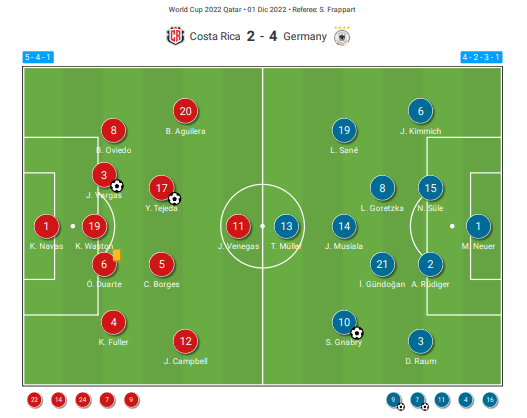
Germany´s attacking style
Germany set up the game in a 2-3-4-1 system, with only the two centre-backs in the defensive line. They let the ball run through their own ranks for a long time.
To get the ball into the opponent’s third, there were several possibilities. Even after losing balls, they kept coming into counter-pressing situations to win the ball back as high as possible. If these were unsuccessful, it led to dangerous counter-attacking situations for Costa Rica, which will be discussed in more detail later.
Since Germany had the ball a lot, they had to think of different options to get dangerously in front of the opponent’s goal. With many attacking and strong players in the starting line-up, Flick tried to break through Costa Rica’s defence with combination play.
Gündogan, as the only central midfielder, often picked up the ball in the build-up and then distributed it either to the flanks or the spaces in between. As Costa Rica were very compact in the centre with their five-man and four-man backline, there were sometimes spaces on the wings.
Nevertheless, Germany tried, again and again, to combine through the centre and to advance dangerously with quick passing combinations.
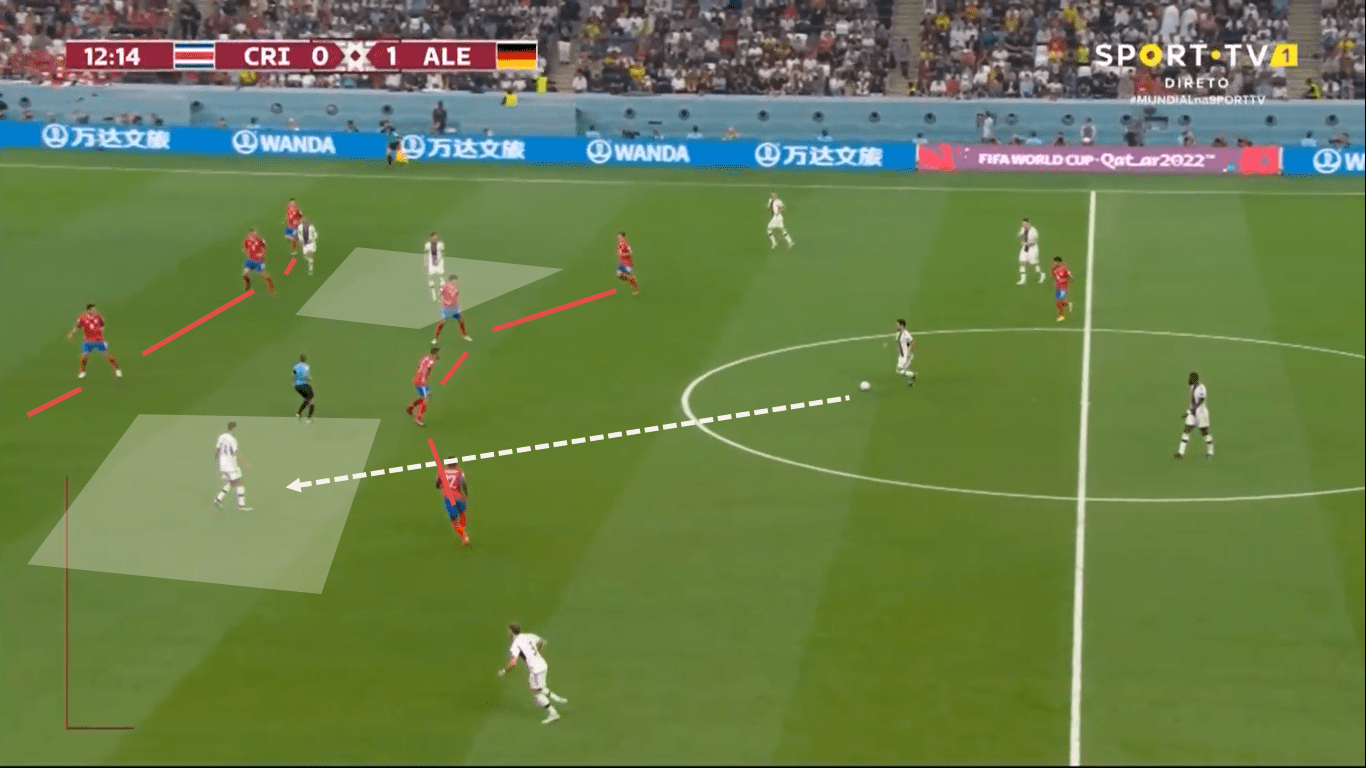
In the picture, you can see how Germany set up in the game with the ball. Süle and Rüdiger were the only two defenders. In front of them, as already mentioned, Gündogan picked up the ball to be able to distribute it further.
Costa Rica played defensively against the ball in a 5-4-1, where the striker did little defensive work and mostly had no access. Typical gaps were created between the two Costa Rican lines.
The Germans often tried to play into these spaces and were thus able to play over the front line. Musiala and Goretzka often moved into these spaces. From there, the game could be continued either by a shift over the side or a deep ball.
Another possibility in the build-up play of the Germans was for the nominal left-back to run in front of the left winger and thus tie up the outer defender of the opposing defensive line. To do this, the winger drops a little to be able to play from his own centre.
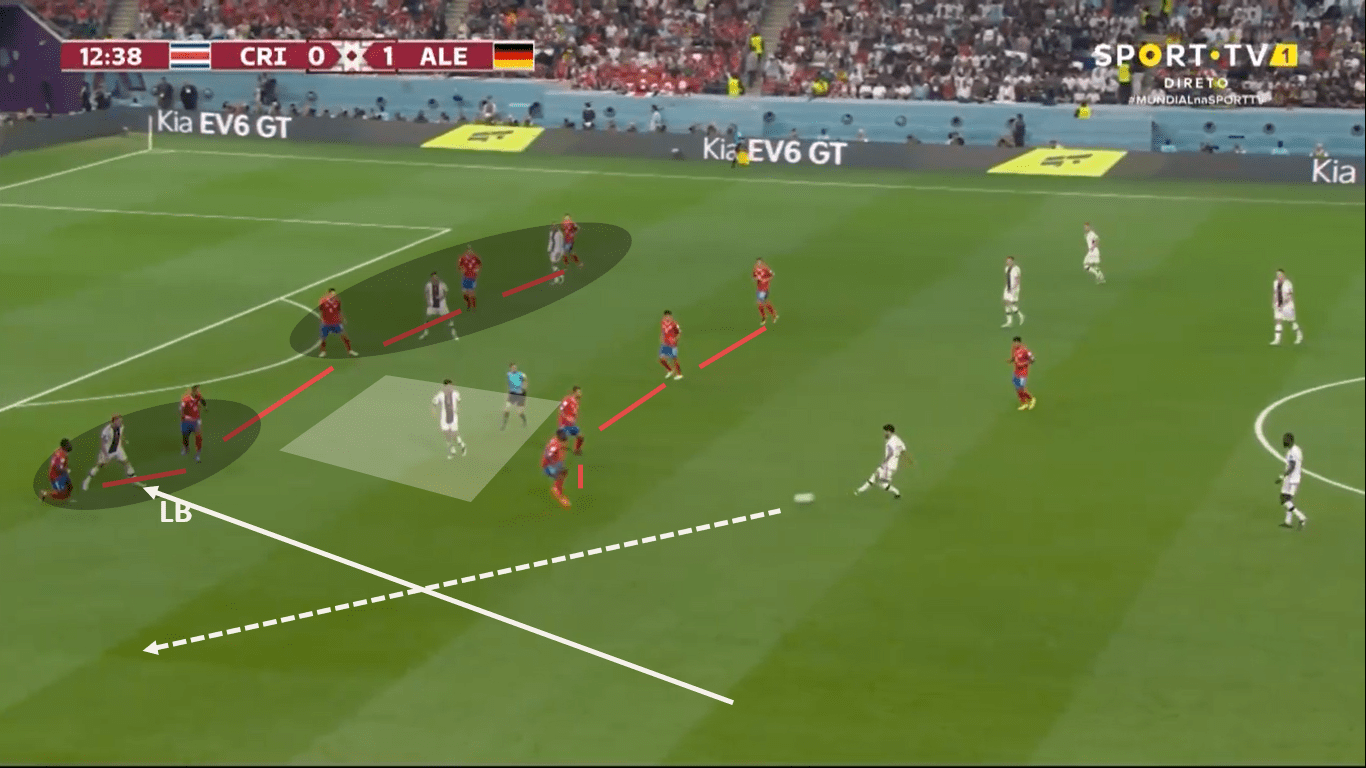
Here you can see how Costa Rica are again set up in their defensive formation. Gündogan again opens the game from the centre and Musiala moves as before in the space in between.
However, this space is deliberately closed by the two Costa Rican midfielders to avoid playing behind the first line. In the process of this freeze frame, the left defender of Germany has run in front of his frontman Gnabry. He is now on the last line and ties up two defenders of the opponent at the same time.
In addition, on the other side, the right winger and the nominal striker tie up three more defenders. By running into the half-space between the chains and tying up the defensive chain, a lot of space is created on the left wing.
There, the left winger can break away a bit to be played and then drive the ball forward. Then he has two options: Either his own left defender comes along on the wing and creates a 2vs1 or he crosses to the second post where the other two offensive players can run in.
As we have just seen, Germany also resorted to crosses from time to time. You could also see a tactical orientation here.
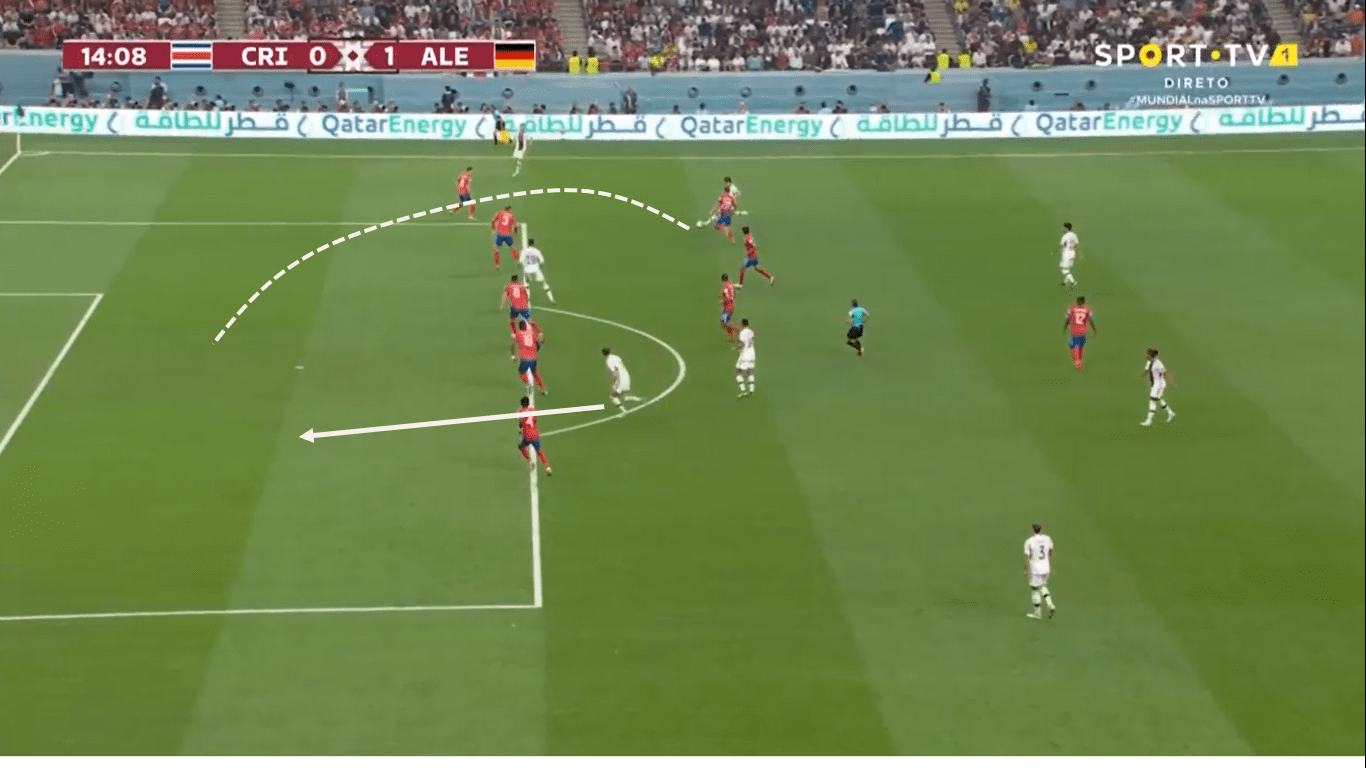
Here you can see another example of the cross. Due to the high full-backs of the Germans, they repeatedly came into areas on the pitch from which a cross made sense.
You could see that the crosses kept coming towards the far post. With three attacking players in the centre, these were well-distributed. One of the three came to meet the crosser in order to create space in the middle.
The player with the stronger head of the other two ran between the right centre-back and the full-back into the penalty area towards the second post. And the third attacking player from the centre was ready for possible passes in the back of the defensive chain but also closer to the goal than the opposing midfield.
Costa Rica´s chances after winning the ball and Germany´s mistakes in defence
Germany had very long periods of possession time and again, as evidenced by a 70 per cent possession rate in the first half alone. In the process, the ball almost always ran through their own ranks in the opponent’s half. When Germany lost the ball in the opponent’s half, they often won it right back.
Because Costa Rica played in a deep 5-4-1, it took them a long time to be able to start an offensive-switching action. The only striker generally had little connection to the game and did not defend.
This created large spaces between the midfield line and the striker. There, Germany often had technical problems and then lost the ball. Since Germany played with the ball in a very open formation, the defensive switching movement was all the more important.
And it was precisely in such situations that Costa Rica sensed their chance. If the counter-pressing did not work and at the same time their own midfield line was able to move quickly enough, it could become dangerous. This is how they were able to score the equaliser.
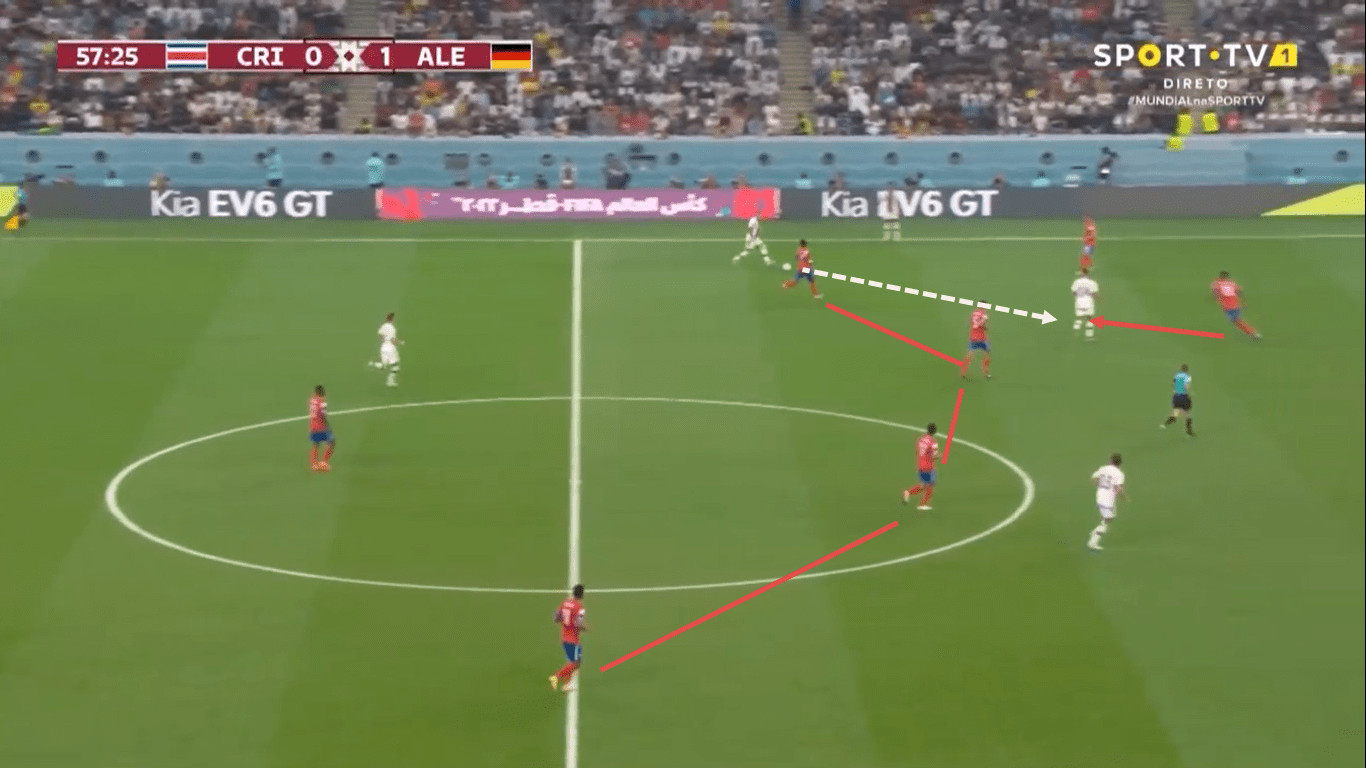
In the situation shown, Germany tried to build up play via the left side with the left back. Residual defence in this game situation consisted only of the two centre-backs and the central midfielder Kimmich.
They again tried to play the spaces between the lines. Costa Rica generally defended more courageously in the second half, including in this situation. The central defender attacks the ball played and is thus able to win it.
Costa Rica’s entire midfield line has not yet dropped deep and can immediately switch to the offensive. The centre-back who has won the ball also joins in the counterattack.
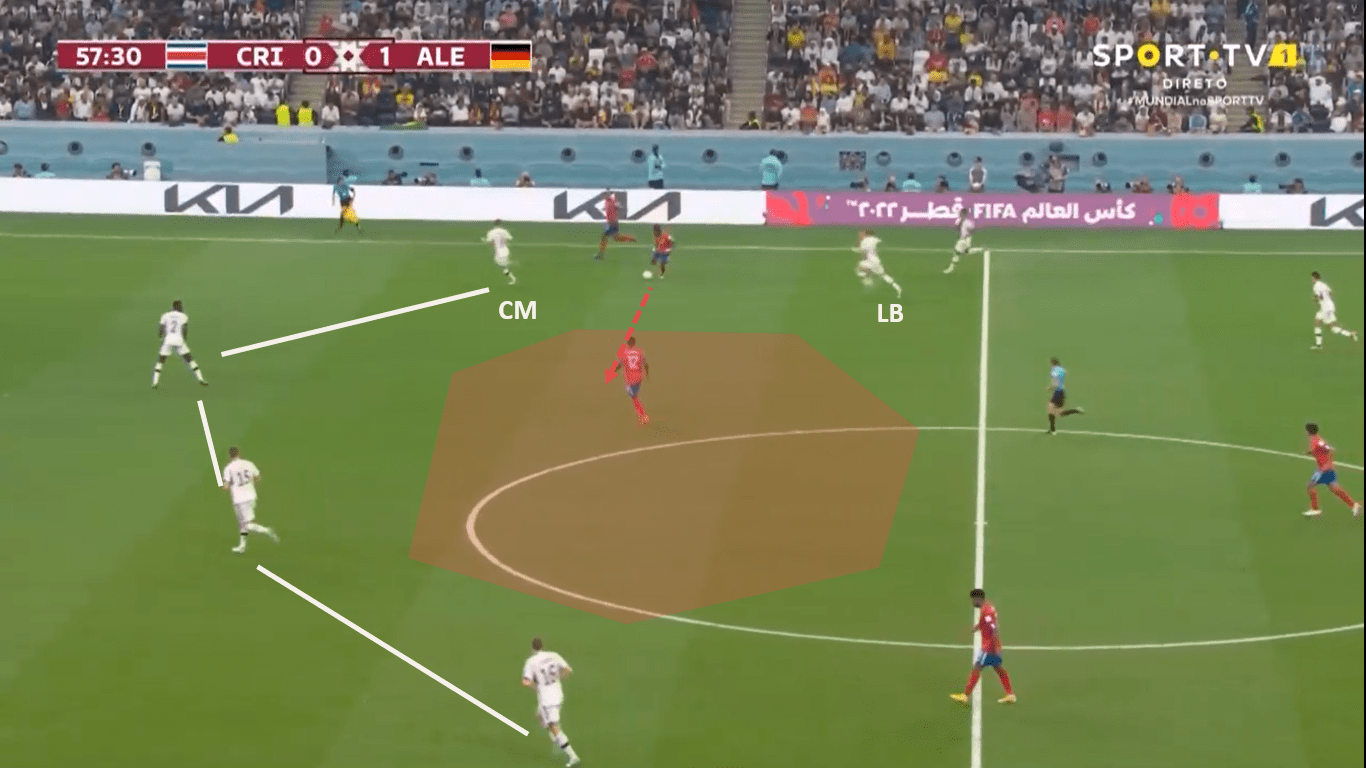
Here you can see how the central midfielder has to act as a left defender to close down the side. Accordingly, a large free space is created in front of the falling defensive chain. The running back’s left defender would have had to move directly into it because his left side was already closed.
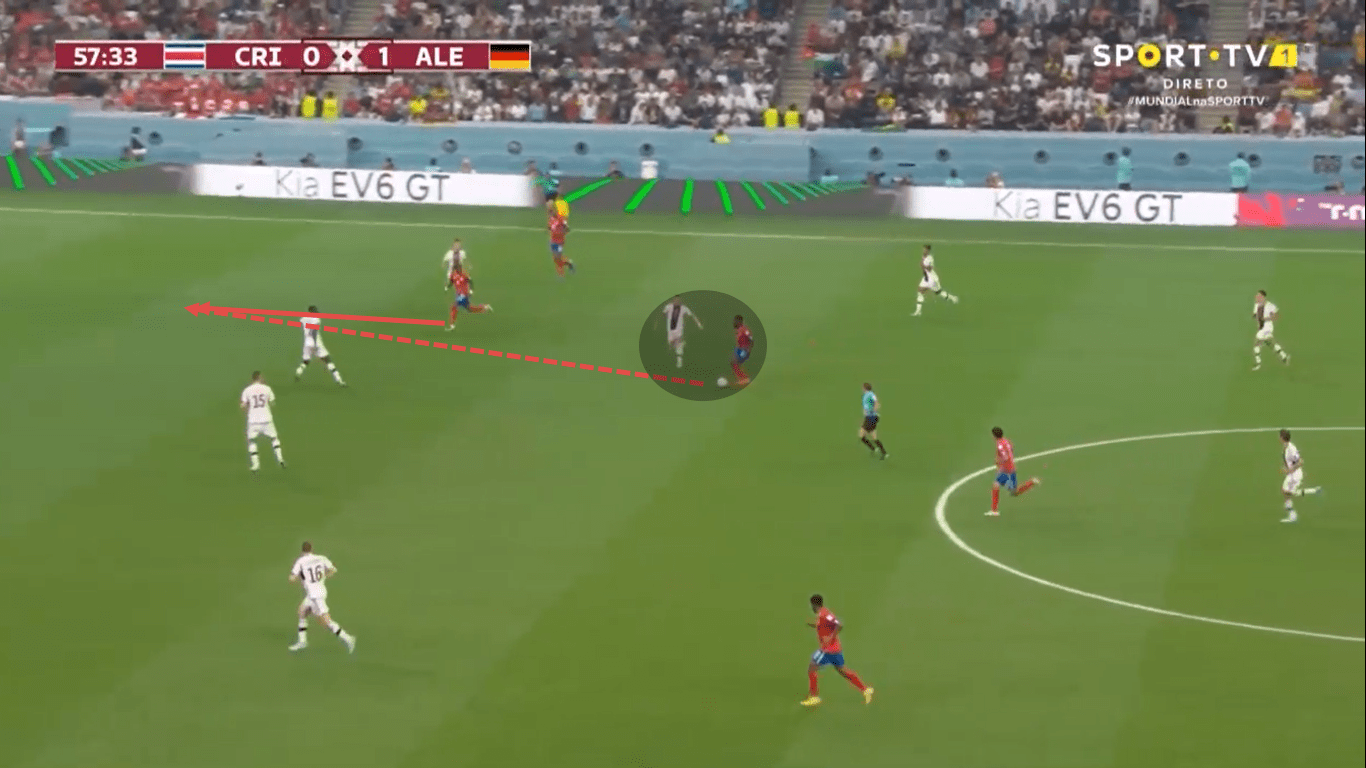
Only now can one see that the free space in the centre is attacked by the nominal left defender in order to prevent the opposing player from passing. Nevertheless, this pressure on the player with the ball comes too late.
The fact that the Costa Rican centre-back, who had previously won the ball by defending in front of it, joins in and creates a surplus on their right-hand side. This superiority makes it difficult for the left defender in this situation.
A perfectly timed ball allows the Costa Rican player to run over the defence and thus get in front of the German goal. Nevertheless, it can be said that there is too little contact with the starting player when playing the ball.
Since there is only one Costa Rican offensive player in the centre, at least one centre-back could have clearly orientated himself towards this. He could have realised early on that the only option in this scene could be a lowball, as the incoming player was already at a high running pace.
If the attacker nevertheless got the ball played into his foot and Germany’s left centre-back defended deep, he would run into two more defenders. Then he could only cross in front of the defence and hit the other centre-back first.
Nevertheless, Costa Rica was able to play the ball deep in this situation and thus not only become dangerous but also score the goal to equalise in the meantime through players from far away from the ball.
Costa Rica´s difference in defence performance between the first and second half
In Costa Rica’s defence, you could see differences between the first and second halves. They became more courageous in defence, especially after the equaliser.
In the first half, they repeatedly had problems defending the spaces created by their basic defensive order. The midfielders could neither close the passing line nor could the centre-back interfere decisively when receiving the ball.
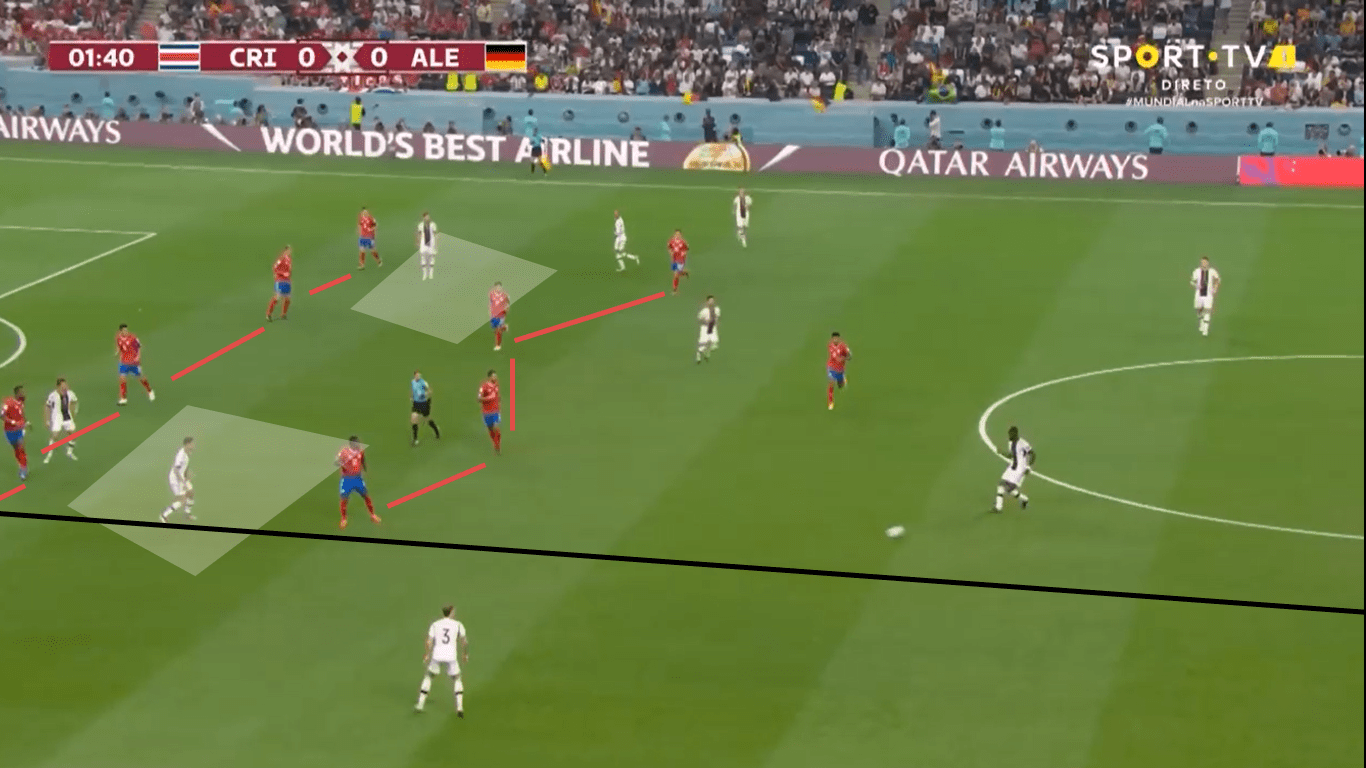
One can clearly see the 5-4-1 system described above as well as the gaps mentioned several times. It is also noticeable that the entire Costa Rican team shifts very closely in order to keep the distances within a line as narrow as possible.
These close distances to the person next to them close the passing lines through the chain. However, if the opponent shifts sides quickly, it is difficult for the midfielders to cover the long distances quickly enough to defend again.
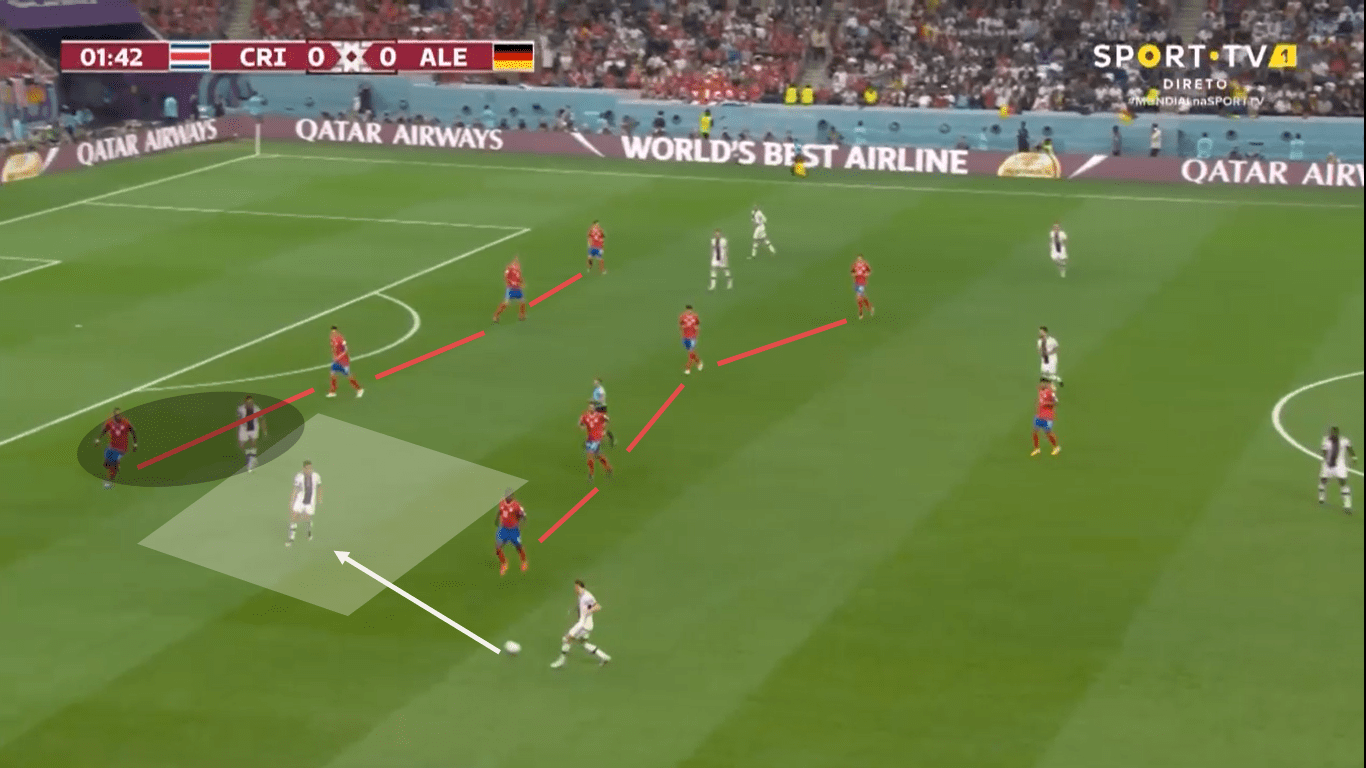
In the continuation of this game scene, you can see the problem in the spaces in between. The ball into this space is not played through the interface between two midfielders but around the outside player. This is due to the long paths created by the lateral shift.
The right centre-back in the three-man backline is bound by the striker and thus cannot interfere with the reception of the ball. In this case, Musiala, who is played on, can turn up undisturbed and dribble between the two defensive lines towards the goal.
In the second half, Costa Rica changed the way they defended the spaces in between to improve and at the same time switch more dangerously. The outside centre-back of the three on the near side of the ball moved into the space in between to disrupt when he received the ball or to be able to attack the pass.
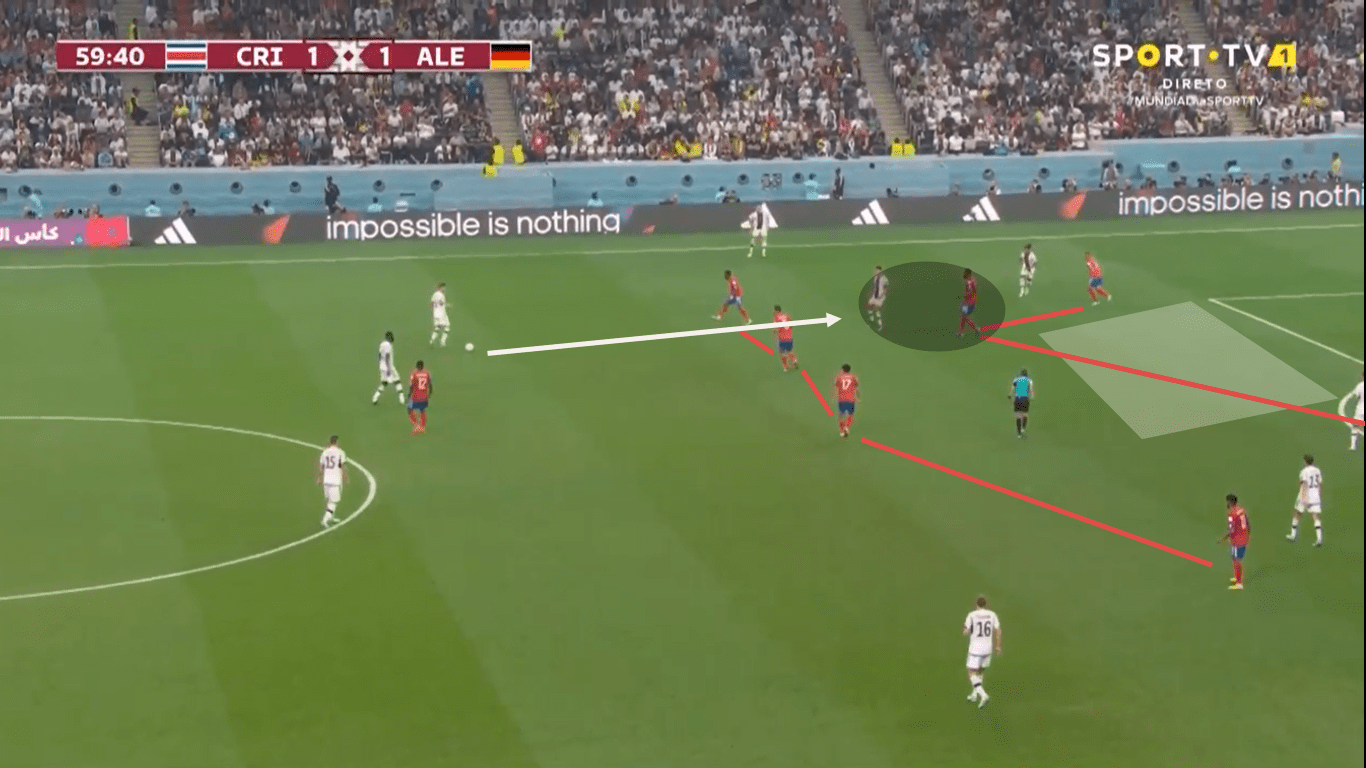
Here you can see how the centre-back makes close contact with the German offensive player in the space between them. Although there is a large gap behind him, this is also secured.
With the three midfielders closely spaced, the passing line into this space is almost closed, making it very difficult, In addition, the centre-back is prepared to possibly defend deep.
With this change, the German offensive players were no longer able to open up undisturbed in the previously available spaces and provide a scoring threat. Nevertheless, some of their individual class flashed and they were still able to be dangerous through these spaces.
Conclusion
Finally, we will summarise the most important tactical points that have just been analysed:
Germany seemed to have everything under control in the first half and were able to get dangerously in front of the opponent’s goal through different attacking variations. Thus, they also took the lead. Nevertheless, they could not make use of their clear field superiority and failed to score the second goal.
In the first half, Costa Rica largely restricted themselves to their own defence. They were always on the lookout for technical mistakes by the Germans in midfield so that they could move quickly with their midfield after winning the ball in the centre. However, Germany was able to prevent this as far as possible through strong counter-pressing from above.
In the second half, Costa Rica had better control of the spaces in between and were thus able to get into dangerous switching situations. This is how the 1-1 result came about after winning the ball in these spaces.
Nevertheless, the Costa Rican defence was no longer able to withstand the concentrated offensive power of the Germans after the surprising lead. The individual quality was too high and Costa Rica could no longer close all the spaces as a collective.
The final score of 4-2 from the German point of view did not bring anything to either of the two teams and thus both were already eliminated in the group stage.





Comments